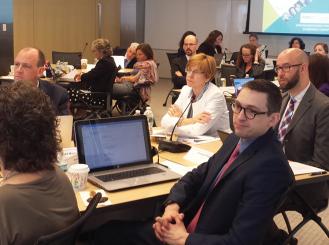Oct 23, 2017
By Caroline Hopkins, ASCO Publishing
On average, only 3% of adult patients with cancer choose to enroll in clinical trials. The statistic poses a great dilemma when we consider that without clinical trials, new research and treatment options remain at a standstill. Clinical trials test treatment efficacy, identify accurate diagnoses, and help drugs receive approval. Clinical trials save lives.
So why, then, do so few patients participate?
According to a 2016 national survey conducted on behalf of Memorial Sloan Kettering Cancer Center, one of the most widely experienced barriers is cost: 50% of respondents cited out-of-pocket costs as a reason not to enroll in clinical trials.1 More troubling, these cost barriers disproportionately affect patients in certain income brackets; patients with annual household incomes below $50,000 are 27% less likely to enroll.2
This widespread cost burden prompted ASCO’s Health Disparities and Cancer Research Committees to convene ASCO’s first Roundtable on Addressing Financial Barriers to Clinical Trials Participation, held in July 2017 at ASCO’s headquarters in Alexandria, VA.
The roundtable was supported by a grant from the Lazarex Cancer Foundation and was chaired by Karen M. Winkfield, MD, PhD, and Beverly Moy, MD. Participants included 25 stakeholders from across the cancer care continuum. Community and academic oncologists, patients, researchers, health economists, insurers, and representatives from the federal government spent the day discussing a collaborative plan to overcome the financial barriers preventing clinical trial enrollment.
Veena Shankaran, MD, MS; Yousuf Zafar, MD, MHS; and Michael T. Halpern, MD, PhD, MPH, identified the root causes of financial burden and spoke on specific ancillary costs that enrolled patients often face. Even when patients have insurance and the cost of the trial itself is covered, they explained how deductibles, copays, and coinsurance can make it difficult for participants to afford the frequent clinical visits and screenings.
Apart from costs of routine care, patients enrolled in clinical trials can also face unexpected logistical costs. These include traveling to trial locations, finding lodging, securing childcare at home, and accounting for lost paychecks when these patients—and in many cases their caregivers, too—are not able to work.
In an effort to develop a system-wide solution, roundtable attendees explored past and current models that have proven effective. Models discussed included targeted clinical trial recruitment and financial assistance and reimbursement programs, among others. Ryan D. Nipp, MD, MPH, discussed Lazarex and Massachusetts General Hospital’s joint Cancer Care Equity Program, which provides assistance for patients’ unique financial needs during clinical trials. Participants noted that, while financial assistance programs provide crucial help to patients, more permanent policy solutions are also needed.
Roundtable participants zeroed in on how policymakers can play a role in surmounting financial barriers. Blase N. Polite, MD, MPP, spoke about how current changes driving quality and value in health care under Medicare could impact clinical trial affordability.
As a next step, ASCO plans to release a white paper summarizing the roundtable’s takeaways. “We were thrilled with the expertise and the robust discussion,” Dr. Winkfield said of the roundtable. “The Health Disparities Committee of ASCO looks forward to publishing our recommendations in the near future.”
References


Comments
Mark Allen O'Rourke, MD
Dec, 05 2017 10:05 PM
In my experience as a medical oncologist enrolling hundreds of adult patients in CCOP and later NCORP clinical trials, the most widely experienced barrier is not cost. More common barriers to clinical trial enrollment are 1) lack of an available trial for the particular diagnosis and stage, 2) narrow eligibility criteria, 3) being overwhelmed by the new information of cancer diagnosis and treatment, 4) limited medical literacy and understanding, and 5) long, intimidating consent forms. No one will argue against financial assistance programs but they are not the key to substantially increasing the 3% clinical trial participation rate. There are ongoing efforts to better explain clinical trials to the public and to patients, to use less restrictive eligibility criteria, to help patients navigate the experience of a new cancer diagnosis, and to streamline the consent and regulatory process. These may increase clinical trial participation rates more than financial assistance programs.
Kirti Jain, MD
Dec, 05 2017 10:17 PM
While cost issues are certainly relevant for low resource patients, I completely agree with Dr O'Rourke about the additional issues he noted.
Add to that the enormous amount of (a lot of it wasteful) paperwork that goes with it. Some sensible reforms are needed.
Tove Godskesen
Dec, 06 2017 6:53 AM
This is a very interesting topic. The issues noted above are part of interview studies we are doing, where we have interviewed oncology/haematology nurses and physicians working with clinical trials in the Nordic countries (not published yet). According to them, most patients are positive to enrolment, costs not being an issue, but some don't participate due to long travels. Another critical issue is the recruitment of ethnic minority participants in clinical trials, as they are not asked about participation due to poor language skills, as you mentioned, Dr O´Rourke. I completely agree with both of you.
T. Godskesen, PhD, RN